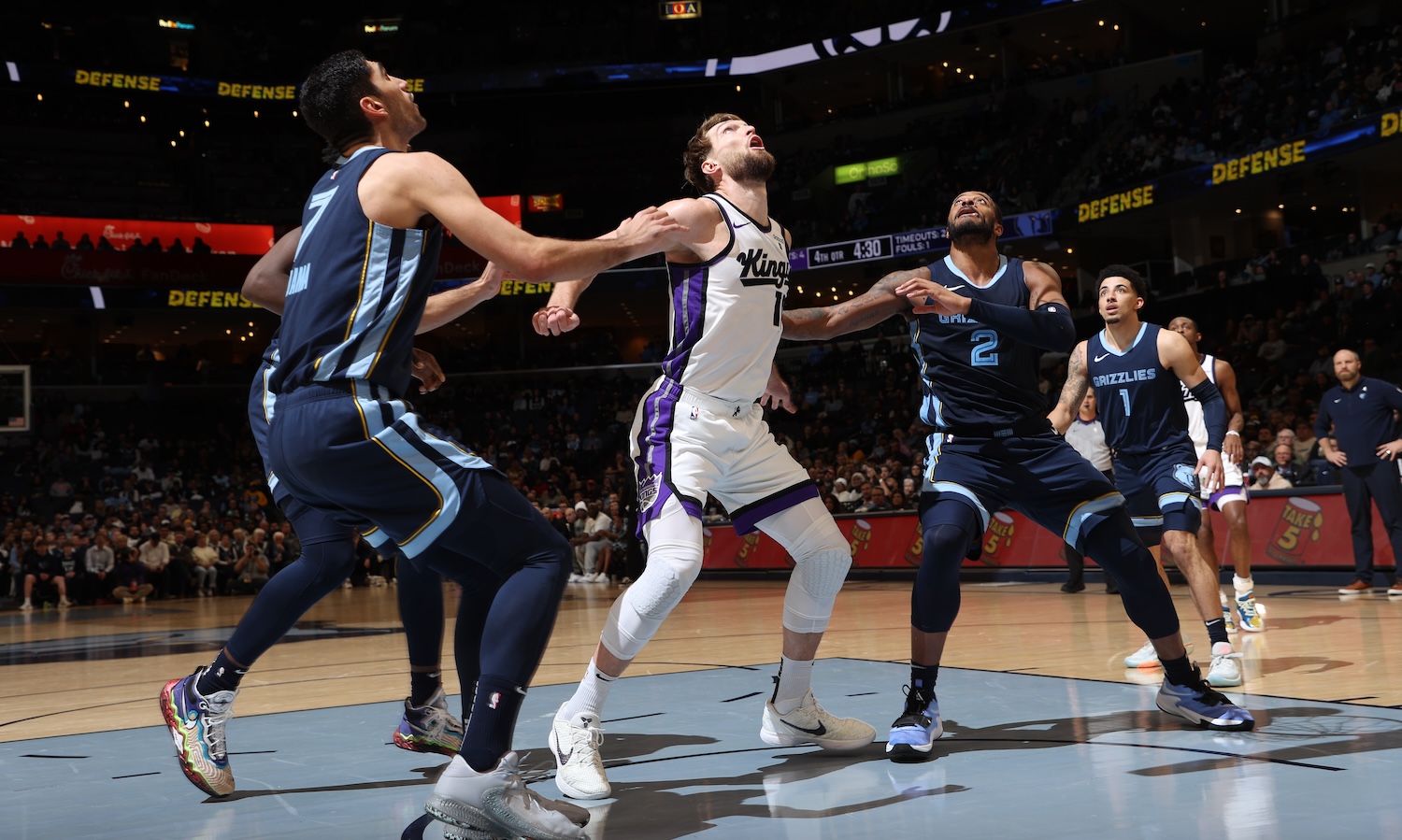The Kings beat the Grizzlies in Memphis on Monday in a wholly unremarkable game, one where the mangled Grizz, with just seven healthy players, had to call up Matthew Hurt from the G-League to meet minimum roster requirements. They kept it close until the end of the fourth quarter, mostly because Sacramento had 19 turnovers and missed their first 12 three-pointers en route to a 28-percent night, and the combination of talentlessness and crummy shooting meant nobody involved in the turbid affair had a night to remember.
Except for Domantas Sabonis, that is, who was comfortable in the mud, scrapping and fighting his way to a rugged 20-point, 26-rebound night on 10-for-11 shooting (exclusively at the rim). It was the best game on the glass this season for the NBA's leading rebounder, and one that his team absolutely needed.
On the occasion of a borderline all-star winning an ugly game for his team by grabbing boards, and in a time of widespread quantitative anxiety, let us consider the humble rebound. Scoring and assist numbers have radically increased over the past decade, the consequence of near-universal adoption of five-out basketball, to the point that someone like P.J. Washington can drop 43 on nothing but catch-and-shoot jumpers, or someone like Luka Doncic will go off for 73 and prompt a widespread reaction that the league is broken. This has less to do, I think, with revulsion with the aesthetics of the modern game (though it doesn't have nothing to do with it) and more to do with a sense of unfamiliarity. It's not simple to contextualize a 30-point night anymore, and it's hard to make sense of the Pacers beating the Hawks 157-152. The playoffs are, to an increasing degree, distinct from the regular season, which makes everything even harder to square. For some, it's better to change the rules to make scoring make sense than to incorporate the tenets of a new reality.
But if pace-and-space is a modern phenomenon whose outer edges we're still familiarizing ourselves with, rebounding is eternal—and more interesting to watch than ever. A second-order effect of the game's enspacening is that bigs have more ground to cover, which makes the grabbing of rebounds more difficult and impressive. Two decades ago, rebounds bounced shorter and did so into denser thickets of taller dudes. Nowadays, most bigs on the floor are out there alone, and the process of boxing out is a more expansive one, as the lane is freer and there are more open angles from which to crash the glass. The best rebounders therefore have to both fight the people around them for positions and angles and contend with screamers from outside looking for tip-dunks and the like.
Sabonis led the league in rebounds per game last year with 12.3, and this year he's up to 13. For someone equally praised (when he tosses 15 assists) and disparaged (when you see that Malik Monk has the most blocks on the team this season) for the finesse he plays with, it can be easy to miss that Sabonis is a nasty rebounder. He's always getting hit in the face because he is putting his body into people on every play. He wields his shoulders like warhammers. He's not as sproingy as Clint Capela or as stretchy as Rudy Gobert or Anthony Davis; his rebounding game is one of physical immediacy and combat skills. This is why I like watching him play younger, reedier geniuses like Chet Holmgren and Victor Wembanyama. The two bucatini aliens seem custom-built for the modern era, though when faced with an insistent physical force like Sabonis, they're unable to keep him from creating whatever space he wants.
The following highlight shows it all. Sabonis sets up an open shot and driving lane by crossing it over and kicking it out, Harrison Barnes shoots a contested runner instead of dumping it off to Sabonis, and Sabonis then gets three dudes out of the way to grab the board and finish.
Sabonis high-points the ball as well as anyone in the league right now, and better than anyone I've seen grab boards since peak Kevin Love. He's really great at the box-out in space, where his man will be trying to crash from nine or so feet out and Sabonis will stop his momentum and manage his efforts to get free while keeping both of his hands high and watching the spin of the ball. If he's boxed-out or a step late, he doesn't just jam himself in close to the play for the sake of appearing to contest. He instead takes a half-step back to anchor and protect the largest swath of open space he can, which often results in him grabbing long rebounds others would miss. Sabonis is such a good rebounder that the Kings have built some of their offense around his defensive rebounding, as they all trust him to bring the ball up the court after grabbing boards, allowing De'Aaron Fox to fly into open space.
It's often said derogatorily that defense and rebounding are largely matters of effort, which undersells both the skills it takes to be good and the bare fact that exerting effort in such a way is a skill itself. Josh Hart, one of the best rebounding guards in the game, crashes so well not just because he dedicates himself to doing so, but because his sense of timing is fine-tuned. Nikola Jokic is hot on Sabonis's heels, and he's become one of my favorite rebounders to watch for his novel use of the backboard as a tool. Bam Adebayo has incredible hands, and he's never out of position. DeAndre Ayton, for all his faults, knows where to stand, which makes up for his unwillingness to be physical. Aaron Gordon is a favorite rebounder of mine for the way he uses his violent athleticism to become impossible to box out at times.
Sabonis is considered a weaker defender because he doesn't block shots. But not only can he move pretty well in space for a center, I'd argue a ton of his defensive rebounds are de facto blocks. Someone like Jaren Jackson Jr. will drive it on him, then Sabonis will stand him up, force a bad shot, and collect the easy board. That's not a block, but the result is the same. The Kings are the best defensive rebounding team in the NBA, and closing out defensive possessions matters a ton when their perimeter crew is so leaky. That's all Sabonis. He's not a great defender, because he's short for a center and his wingspan is sub-seven feet. But mostly he is a transformative rebounder, a rare role whose impact is hard to fully appreciate. Pat Riley famously quipped, "No rebounds, no rings," and there's real truth in that. Look at the last few champions: L.A., Milwaukee, and Denver were all huge and gnarly, and the 2022 Warriors won in large part because Andrew Wiggins dedicated himself to crashing the glass with force not seen before or since.
If there's a critique of the current era of basketball that actually holds water, it's that most teams play kind of the same way. Not all five-out offenses are clones of each other, but there are a series of common motions and situations that everyone knows how to process—don't help off the strong side corner, roll after setting a screen, hit the corner man before you dribble. Modern offense is not exactly on rails, but everyone shoots so often and so well that three-point luck can feel somewhat determinative, and defense has been defanged to the point that physicality matters less than ever before (again, only in the regular season).
But you can always exert yourself on the glass. That hasn't changed. If anything, winning the possession game is more important than ever, and the skillsets of great rebounders are on display in a way they weren't always allowed to be when every big played alongside another big. No matter how otherworldly offenses get, rebounding will always serve as an equalizer—and a way to clear the path to a ring.






